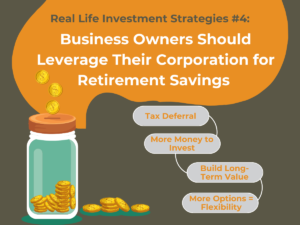When you’re immersed in running a business, thoughts of saving for retirement often take a back seat; Employees in the corporate world may rely on employer pensions, but as a business owner, the responsibility for your retirement falls squarely on your shoulders.
Starting your retirement planning early and consistently contributing allows you to benefit from compounding returns to steadily build your nest egg over time. Investing in your retirement can ensure you have the financial means to enjoy life post-retirement, whether it’s traveling, pursuing new passions, passing along a little financial freedom to family members, and more.
This blog explores how business owners can utilize their corporation (Canadian-controlled private corporations or CCPCs) to retain business income that exceeds operational and personal lifestyle needs.
Changes to Income Tax Rules (Capital Gains Inclusion Rate) can throw Business Owners’ Retirement Savings Plans into Chaos
The 2024 Federal Budget is a perfect example of how income tax rules can change, sometimes less smoothly and with less notice than what is reasonable.
Specifically, the 2024 budget included an increase in capital gains inclusion rate that affects:
- Individuals with over $250,000 of capital gains in a tax year (only on the amount in excess of $250,000)
- Corporations
- Trusts
To make matters worse, the timeframe for any pro-active tax planning was very short and with few specific details before the tax changes became effective on June 25, 2024.
Many have also speculated that capital gain tax increase was a last-minute addition to a budget that was politically motivated and not based on sound economic policy. Among the critics was none other than, Bill Morneau, the former Trudeau-Liberal finance minister.
There is also a high probability that there will be a change in Federal Government in 2025, which may bring a complete taxation review and reform. Among the taxation reforms might be to roll back this tax increase.
Given this context and uncertainty, what should an individual with corporate investment assets do?
The best advice I can give you is to step back and view these tax changes versus your long-term financial goals, and to avoid making hasty decisions. If there is major tax reform in the next few years, many individuals might find their hasty planning decisions to be very costly.
Even with higher capital gains inclusion rates, investing in your corporation still has many advantages.
Using Your Corporation for Retirement Savings still Provides you with Numerous Advantages
Retirees increasingly rely on their savings to sustain their lifestyle after leaving the workforce, presenting unique challenges (and opportunities) for business owners pre- and post-retirement. Over time, these corporations can accumulate investment assets and simply selling the business for retirement funds isn’t always the best option. The corporation can reliably serve as a source of dividends for the owner-manager in retirement. When a corporation is involved, it opens up another retirement savings and withdrawal option which, although advantageous, can be complex. We’ll walk though how saving within your corporation can be a great choice for business owners, but it is quite important to work with a competent independent financial advisor, accountant, and other professionals to determine the best retirement saving planning for each specific situation.
4 Reasons you should be Using your Corporation to Save for Retirement
- Tax Deferral
By retaining excess funds within the company, the initial tax benefit is that the income is taxed at a lower corporate rate vs. your personal tax rate – the extent of the advantage can vary depending on whether your corporation qualifies for the small business tax rate, which would be even more advantageous. Hand-in-hand, the tax benefit is also gained by the postponement of personal taxation. When funds are distributed to the business owner later as dividends, even with consideration of tax integration, the investment returns of the funds held within the company can generally more than compensate.
- Tax Deferral means more Money to Invest Today
By taking advantage of the tax deferral due to the reduced corporate tax rate, you have access to more investable capital today. This increased liquidity opens up the possibility of generating higher returns on your investments within the corporation, amplifying the potential growth of your wealth over time.
- Build Up Long-Term Value of the Corporation
If you plan to sell your corporation down the road, you can also take advantage of the Lifetime Capital Gains Exemption (LCGE), which Budget 2024 is proposing to increase to $1,250,000 (for dispositions after June 25, 2024) when you sell shares in the business. Let’s say you sell a business for $2 million; the exemption amount means you wouldn’t pay tax on 62.5% of that profit. This translates to hundreds of thousands of dollars in tax savings.
In addition, the LCGE is a lifetime limit – so you can also choose to apply the exemption multiple times until you reach the limit. So, you have the option to sell shares over time and use the LCGE for multiple years until you’ve capped out. Figuring out how best to apply the LCGE can be challenging but worth the effort.
Lastly, with proactive planning, leveraging the lifetime exemptions of multiple family members can potentially mitigate or even eliminate the capital gains tax liability on higher-value businesses. A reliable professional financial planner and accountant can help you determine the best way to allocate and dispose of corporation shares to realize the optimal financial result.
- More Options for Savings & Withdrawal Streams = Flexibility
The most important advantage of saving for retirement within your corporation is that it gives you more options for both your retirement savings and investment options and your retirement withdrawal pools. Essentially, it gives you another tool in your toolbox. Most people are limited to three investment streams: RRSP, Tax-Free Savings Account, and Non-Registered Investments.
The corporation gives you a 4th pool of funds to work with – for both saving and withdrawal. This allows for the flexibility to optimally select the best pool of funds for savings and withdrawal over time. For example, in any given year, your lifestyle needs may drastically change, so saving within the corporation gives you one more place to pull money in a way that best works for you. The following year, you have the flexibility to change it up in a way that works better. You don’t need to be limited to only 3 pools of your savings.
Another option that saving within your corporation opens up is the way you withdraw your money – during your prime working years, as you ramp down, and into retirement. Business owners can take money out of the corporation via dividends or salary.
Dividends are not tax deductible for the corporation. But with dividends, there are also no payroll taxes. Dividends also allow for more flexibility around how much you withdraw from the corporation and when. This is a great advantage for changing needs dictated by your personal lifestyle needs.
Withdrawing from your corporation via salary is advantageous due to the tax deduction for the corporation. In addition, salary withdrawal creates personal RRSP investment room. However, you would need to pay CPP at both the personal and corporate level. In addition, other payroll taxes would be required to be paid by the corporation.
Considerations when Saving for Retirement in your Corporation
With so many advantages to saving within a corporation, it may seem like a no-brainer. However, I need to point out some things you should consider as you use your corporation as a retirement savings pool.
Firstly, there is some extra complexity that comes with managing that extra stream of savings, which makes your reliance on a trusted accountant and financial advisor even more important.
Obviously, there are extra costs that come with owning an incorporated business, but if you are reading this blog, you are already paying these expenses. But, due to the extra complexity of managing more, there might be slightly more costs associated for your accountant. Although more cost, it is likely minimal and wouldn’t offset the advantages.
Another consideration about saving in your corporation is how you plan to retire: selling your business, winding down, succession, downsize, family takeover, etc. Thinking about the right path for the specific situation results in questions (and answers) about the best way to proceed. Continue Reading…






